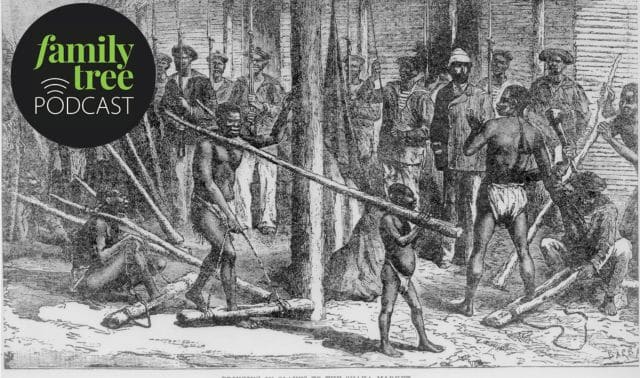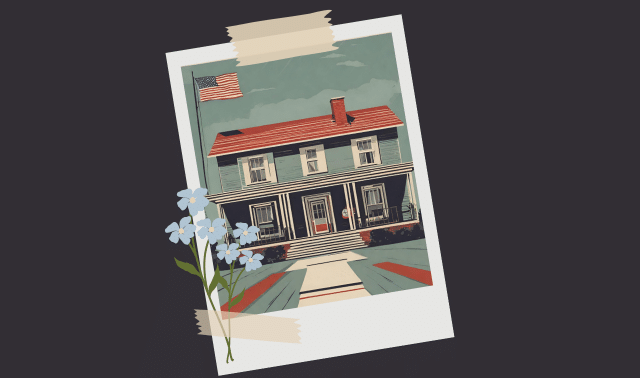Sign up for the Family Tree Newsletter Plus, you’ll receive our 10 Essential Genealogy Research Forms PDF as a special thank you!
Your ancestors lived in Amsterdam in 1810. You live in Albuquerque, and it’s 2010. How do you learn about their world if you don’t have the luxury of hopping a plane to the Netherlands?
It’s easier than you think. A trip to the library can help transport you to your ancestor’s time, and you can create a culinary tour of your homeland right in your kitchen. Add in a letter-writing campaign and a day trip to a living history museum, and you’ve got a summer of genealogical wonders awaiting you. Read on to discover four ways to take a virtual journey to the places, faces and tastes of the past.
1 Read and watch history.
Travel agents and guidebooks help visitors get the most out of their destinations. Similarly, libraries and archives offer tickets to fantastic armchair travel to your ancestor’s era. You can learn about his childhood, domestic life, military life, education, religion, work and immigration through books, videos, pictures and maps. (At most libraries, you can enjoy your virtual travel experience in air-conditioned comfort.)
Several great book series can introduce you to different time periods so you learn how your ancestors lived, worked and played in colonial America or Victorian England. See recommendations on page 31. Like your history with a side of popcorn? Head to the library’s video section. You may find documentaries that shed light on your family past. Search the library catalog for DVDs or videocassettes with keywords such as documentary Victorian or Civil War history.
“Watching a documentary on Ellis Island can help you gain a greater understanding of an ancestor’s immigration experience,” says Christina Rice, a librarian in the Los Angeles Public Library’s History and Genealogy Department. “Pieces on Coney Island or Kennywood Park in Pittsburgh may give a sense of how an ancestor spent leisure time at the turn of the century. Between PBS, the History Channel and local programs, many options are readily available online or through services such as Netflix <www.netflix.com>.”
Online photograph collections at libraries and archives hold millions of images that can help your research even if they don’t depict your ancestors. “Use historical images to gain an overall picture of what your ancestor’s life experience may have been like,” Rice says. “What their neighborhood looked like as they walked through it every day, how they may have dressed, what their home may have looked like.”
Search websites of libraries and archives in your ancestor’s hometown for photo collections, Rice says. Or check the Library of Congress’ Prints and Photographs Division <loc.gov/rr/print>, which has 14 million digital images. Many other online photo archives even allow the public to upload their own pictures. See page 31 for several sites to browse.
When searching for images, be as specific as possible. “Don’t [look] for something broad like Civil War photos when you’re really looking for images of a specific Union regiment,” Rice says. Search on names from your research: surnames, hometowns, street names, churches, schools, hospitals, cemeteries, employers or civic organizations.
Old maps are yet another library resource that can guide you to your ancestors as sure as a modern GPS. “Some historical maps can be so detailed they identify individual businesses, churches, movie theatres—even places or street names that don’t exist any more,” Rice says. “I once looked up an address on a Sanborn fire insurance atlas and discovered a person I was researching lived above a garage in the 1920s, which gave me a sense of the family’s economic situation at the time.” Look for Sanborn maps at state libraries and archives, or see if your local library subscribes to Digital Sanborn Maps <sanborn.umi.com>.
Street and road atlases, topographic and land-use maps, even historic aerial photographic maps exist in several formats. The Perry-Castañeda Library Map Collection <www.lib.utexas.edu/maps> displays thousands of historical and current maps online. You can catch a glimpse of your ancestors’ neighborhood (even their old house, if it’s still there) on Google Maps <maps.google.com>.
2 Dine and dash.
One of the best things about traveling is getting to sample the local cuisine. You’d never visit Maine without eating fresh-caught lobster, and it’d be a crime to go to Crimea without trying the borscht. Likewise, a trip to your forebears’ world would be incomplete without sampling their recipes.
Heritage recipe enthusiast Holly Haynes agrees. “Whenever I smell fried apples, I still think of my great-aunt Florence,” she says. “She and her husband had a farm in Kansas. I would visit, and she would drop whatever she was doing and make time for me. The smell of food brings back memories. But if you don’t have the recipes, you can’t re-create that smell.”
Where can you find old family recipes? Start at home: Ask your relatives what dishes they remember their parents preparing. Did they ever bake with Grandma? What was the traditional fare at family gatherings? Note names, descriptions or types of dishes.
Then turn on your computer. “The internet is a fabulous resource,” says Haynes, editor of <www.heritagerecipes.com>. “A Google search for heritage recipes returns 1.5 million hits. I find so many old recipes just by doing a Google search.” Try searching by ethnicity, culture or religious heritage. Start with terms such as old German family recipes or traditional Swedish recipes.
Search by recipe title or ingredients on culinary websites such as the Historic American Cookbook Project <digital.lib.msu.edu/projects/cookbooks>, a digital collection of some of the most widely used American cookbooks from 1798 to 1922. You can search for modern recipes based on ingredients you want or don’t want on <www.allrecipes.com>.
“You’re going to find a lot of your localized recipes in church and community cookbooks,” Haynes says. Search for cookbook or recipes and the community or parish name on Google Books <books.google.com>, Internet Archive <www.archive.org> or eBay <ebay.com>. You might even try calling a used bookstore in your ancestor’s hometown. Learn more about old cookbooks and find links to examples at <familytreemagazine.com/article/historical-cookbooks>.
Once you’ve tracked down some old recipes, you may discover that interpreting them can be as confusing as reading foreign road signs. “A lot of the old recipes don’t have directions,” Haynes says. “They don’t say how long to bake it or at what temperature. They assume you know. They describe the amount of butter to use as ‘the size of an egg.’ They might ask for obsolete ingredients, like suet or lard—all the old good pie recipes call for lard.”
So how does the armchair time traveler figure out her way to a delicious meal? “I look in a modern recipe book for a similar recipe and use the instructions for that,” Haynes says. “Look online and in specialty markets for obsolete ingredients. You can still find lard in the Mexican food section of a grocery store, where it might be labeled manteca.”
But just as you wouldn’t drink the water in some exotic destinations, you won’t want to use ingredients now known to be harmful. Lye and potash were used as leavening agents before baking soda became widely available in the 1800s. We don’t recommend trying to cook with these caustic chemicals unless you’re a chemist.
3 Step into the past.
Your ancestor’s world may be years—and miles—from yours, but a portal to it may be closer than you think. Living history experiences offered by museums and heritage sites allow you to immerse yourself in long-gone eras. Without traveling too far, you could find yourself at a dry goods store, in the back of a carriage or at an old-fashioned dairy farm.
“There are a lot of role-playing experiences where people actually take on the character of some living person, or interpret a farmer, cooper or blacksmith for you,” says Judith Sheridan of the Association for Living History, Farm and Agricultural Museums <www.alhfam.org>. “The person can answer your questions. They physically demonstrate or help you do something you wouldn’t normally do.” Like what? “A lot of our sites allow you to plow behind a horse or mule or ox. You can watch the earth turn over as the horse is walking in front of you,” she says. “Or you might be in a kitchen with a wood stove, watching someone make jam or bread.”
Even if your great-grandfather didn’t farm the exact same acres or stand guard at the fort you tour, you’ll still walk away with fresh insights, and maybe even new research ideas. Let’s say your ancestor mined coal. You tour the Beckley Exhibition Mine in West Virginia <www.beckleymine.com>. In the dark mine shaft, you recall your grandmother’s recounting of delivering lunch to her father. You form a vivid image of a terrified 9-year-old inching through the damp darkness with only a lantern.
Then you tour the mine camp’s display of historical documents. A company newsletter proudly reports a spelling bee won by the foreman’s daughter. A yellowed 1939 payroll statement itemizes a miner’s 77-hour pay period, minus his rent and company store account. Old group photos capture whole shifts of workers in hardhats and stained overalls. You’ve now learned a lot about life in a coal town—and found clues about records that might exist from your ancestor’s life.
Living history experiences include agricultural and maritime museums, military sites, parks and even whole villages re-create bygone times. The earliest days of European settlement, the Great Depression and even the 1950s are represented across the United States, from Plimoth Plantation in Massachusetts to a gold mining town in Columbia, Calif.
If you live in an area where many members of your heritage group settled, you might find a local living history interpretation that offers a window to the Old World. For example, look for Scandinavian sites in Minnesota, German farms in Pennsylvania and Spanish missions in California. The Association for Living History, Farm and Agricultural Museums maintains an online directory of living history sites across the United States and abroad at <www.alhfam.org>, as does American Heritage Sites <www.heritagesites.com>. Consult regional travel guides or tourism bureaus for more information.
4 Write away.
Another way to make the most of your “staycation” this summer is by inviting your ancestors to your home. Locate and request copies of their records through a time-honored method: letter-writing.
You can request just about anything through the mail, says Christine Crawford-Oppenheimer, author of Long-Distance Genealogy (Betterway Books). “A lot of the records you need are not available on the internet, especially if they’re older than 100 years,” she says. In her experience, the records you have to write away for often contain the most information.
Many repositories accept only written requests, and if you write a letter, you’ll ensure you won’t leave out important details or fatally mispronounce a name. What’s the first record Crawford-Oppenheimer writes away for? “Estate files can be very helpful in putting together a family because they often have relationship information. You might find someone’s will transcribed online, but there won’t be the other papers to go with it. In the estate papers, there may be lists of names of children and even ages or clues to their ages.”
She also likes to request land records. Property descriptions can evoke the view outside your ancestor’s front door: buildings, fences, fields and roads. Ownership records may mention the owner’s spouse(s), heirs, neighbors (who might be relatives), trusteeship for a church or civic organization, kinship between buyer and seller, or a previous residence.
Crawford-Oppenheimer has found that original paperwork usually contains more information than an online index. Marriage applications may include ages or birthdates, birthplaces, occupations, previous marriages, and parents’ names. Social Security application forms (SS-5s) have similar data. Military pension files may reveal names and death dates of the soldier’s spouse(s) and children. It’s worth writing to get the whole story.
You can request some records, such as SS-5 forms, online. But you’ll send most requests in writing. First, find out where records are located using the The Family Tree Resource Book for Genealogists edited by Sharon DeBartolo Carmack and Erin Nevius (Family Tree Books) or Red Book: American State, County and Town Sources edited by Alice Eichholz (Ancestry). Next, check the agency’s website, Crawford-Oppenheimer says. “See if they really have the information the book says they have. Sometimes you’ll discover that they’ve digitized the stuff you want to see. Sometimes you’ll find you can contact them by phone or print out forms.”
To make sure you get the most out of the fees you send, “be very clear about what you want,” Crawford-Oppenheimer says. “Give thorough information (such as birth and death dates and places) so they know they’re getting the right person. You might find there were two or three people of the same name. And ask for copies of an entire file: not just the will, but the whole estate file.”
Waiting for an answer can try your patience. It can take weeks—or even months—for some institutions to respond. (It’s worth noting that many record repositories are staffed by volunteers.) If you feel your request has fallen through the cracks, Crawford-Oppenheimer suggests writing a polite follow-up letter. “Don’t just say, ‘Where’s my money?’ Say, ‘I’m worried my letter might have gotten lost.’” And send all the details from your first letter again in case it did.
Like any trip, your armchair excursion into the past is taken at your own risk. The heavenly dishes you remember from childhood might flop in your oven. Records for which you check the mailbox daily might not even exist.
But if you keep traveling, you’ll eventually arrive at a better understanding of the past. You could watch a WWII documentary with your uncle that finally gets him to talk about his time as a GI. You could get the hang of those dumplings, and your chicken soup will become as beloved as your grandmother’s. And one day, a thick packet will come from a little historical society that helps you finally break through that brick wall. Then you’ll know that every missed turn or detour was worth the effort.
Tip: Use a genealogy “staycation” to catch up on tasks such as conducting and transcribing phone interviews, posting queries online, scanning photos and organizing your files.
More Online
Free Web Content
n Seven steps to study ancestral places
<familytreemagazine.com/article/ancestralplaces>
n Searching library catalogs <familytreemagazine.com/article/
catalog-shopping>
n Access NARA from home <familytreemagazine.com/article/
nara-from-home-1>
For Plus Members
n 14 genealogy tasks to do on your lunch break
<familytreemagazine.com/article/power-hour>
n State Research Guides
<familytreemagazine.com/articlelist/states>
Family Tree Shop
n Family Tree Legacies
<shopfamilytree.com/product/family-tree-legacies>
n Passport to Europe CD
<shopfamilytree.com/product/family-tree-passport-to-europe-cd>
From the August 2010 Family Tree Magazine




